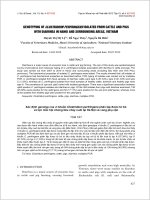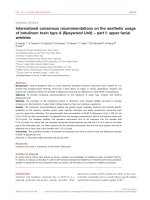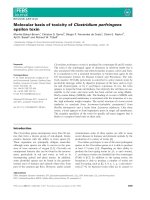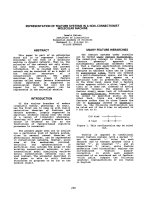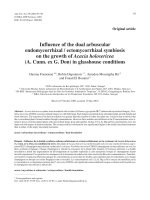Influence of growth stages and nutrient media on production of membrane vesicles of clostridium perfringens type A and their molecular characterization
Bạn đang xem bản rút gọn của tài liệu. Xem và tải ngay bản đầy đủ của tài liệu tại đây (298.64 KB, 9 trang )
Int.J.Curr.Microbiol.App.Sci (2018) 7(7): 2827-2835
International Journal of Current Microbiology and Applied Sciences
ISSN: 2319-7706 Volume 7 Number 07 (2018)
Journal homepage:
Original Research Article
/>
Influence of Growth Stages and Nutrient Media on Production of
Membrane Vesicles of Clostridium perfringens Type A
and their Molecular Characterization
Deuri Nirab Kumar1*, Sharma Kr. Rajiv2, Borah Probodh1, Hazarika Parishmita2,
Sonowal Joyshikh1, Borguhain Indrani1 and Pathak Bedanta1
1
Department of Animal Biotechnology, 2Department of Veterinary Microbiology,
College of Veterinary Science, Assam Agricultural University,
Khanapara, Guwahati-781022, India
*Corresponding author
ABSTRACT
Keywords
Clostridium
perfringens,
Membrane Vesicles
(MVs), SDS-PAGE,
PCR
Article Info
Accepted:
20 June 2018
Available Online:
10 July 2018
All Gram-negative bacteria and a few gram-positive bacteria shed membrane vesicles in
suitable medium and environmental condition. The present study was undertaken to
determine the influence of stages of growth and nutrient media on production of membrane
vesicles (MVs) of Clostridium perfringens type A (C. perfringens type A), and molecular
characterization of the same. An isolate of C. perfringens belonging to type A was selected
and grown in Trypticase Peptone Glucose broth (TPGB) and Robertson's Cooked Meat
broth (RCMB) media. The MVs were extracted at 4, 8, 12 and 24 hours of growth. The
protein profile based on SDS-PAGE revealed the appearance of six bands at 4 and 8 hrs of
growth, with one prominent band and nine bands at 12 hrs of growth on TPGB. No bands
were observed in MVs extracted at 24 hrs of growth in TPGB. The molecular weight of the
protein bands ranged from 43.3 kDa to 75.2 kDa. The MVs extracted from RCMB medium
revealed the appearance of six protein bands at 4 and 8 hrs and nine bands at12 hrs of
growth with six prominent bands. The 24 hrs growth culture in RCMB also revealed no
bands in SDS-PAGE. The RCMB protein bands also ranged from 43.3 kDa to 75.2 kDa.
The DNA content of MVs was demonstrated by PCR and presence of DNA 16S rRNA and
cpa (alpha toxin) genes in MVs was confirmed. Agarose gel electrophoresis revealed two
distinct bands of 795bps and 324 bps of 16S rRNA and cpa (alpha toxin) genes,
respectively.
Introduction
The clostridia are saprophytes and ubiquitous,
large gram-positive bacteria, which are
anaerobic, fermentative, catalase-negative,
spore-forming, rod-shaped and require
enriched media for growth. They are found
mainly in the habitat of organic compounds,
including soil sewage, sediments, intestinal
tract of humans and animals1. Clostridium
perfringens produces over 15 different toxins,
out of which only four are identified as major
toxins, viz. alpha (α), beta (β), epsilon (ε) and
iota (ι), while the others are considered to be
2827
Int.J.Curr.Microbiol.App.Sci (2018) 7(7): 2827-2835
minor toxins2. On the basis of the major toxin
production, either alone or in combination, C.
perfringens is classified into five toxin types,
viz. A, B, C, D and E3, 4. The organism is
associated with diseases like haemorrhagic
abomastitis and haemorrhagic diarrhoea in
calves and foals5, necrotic enteritis and
necrotic enterotoxaemia in pigs6, pulpy kidney
disease in sheep of all ages7, gas gangrene in
animals and human beings8, necrotic enteritis
and cholangio-hepatitis in poultry9, and
necrotic enteritis and food poisoning in
children10.
Membrane vesicles (MVs) are spherical,
bilayered structure, 20-250nm in size, and
produced by the gram-negative as well as
gram-positive bacteria in non-replicative form.
They are complex, chemically heterogeneous
bilayered structure11. Secretion of membrane
vesicles is an evolutionary conserved and
universal process that occurs from simple to
multicellular organisms. The MVs are
produced by the organismsin-vitro12 or invivo13condition during their cell growth14.
Membrane vesicles contain important surface
antigens,
such
as
peptidoglycan,
lipopolysaccharide, lipoprotein, membrane
protein, cytoplasmic content, periplasmic
content, DNA, RNA (tRNA, rRNA),
cytokines and enzymes15. Production of the
bacterial MVs is reported to be dependent on
different factors, e.g. cultivation time, growth
media, physical and chemical stress16.
The aim of this study was to determine the
molecular characteristics of the membrane
vesicles of C. perfringens type A and the
effect of nutrient media and stages of growth
on production of membrane vesicles in invitro condition.
Materials and Methods
Bacterial strain: Five isolates of C.
perfringens were obtained from the repository
of Department of Veterinary Microbiology,
College of Veterinary Science, Assam
Agricultural
University,
Khanapara,
Guwahati-22. All the five isolates were
reconfirmed by inoculating onto 5 percent
(v/v) sheep blood agar to observe the typical
smooth, round and glistening colonies
surrounded by inner zone of complete
haemolysis and outer zone of partial
haemolysis as described by Baldassi et al.,
(2002). All experiments were performed
anaerobically in the anaerobic jar with
anaerogas pack system (Hi-Media, Mumbai,
India) at 37C for 24 hrs. Further confirmation
of the isolates was done based on cell
morphology and staining characteristics by
staining the smears with Gram’s strain.
Molecular confirmation by PCR: All five
isolates were screened for the virulent genes,
cpa (alpha toxin), cpb (beta toxin), etx
(epsilon toxin) and iA (iota toxin) by simplex
PCR as per the method described by Titball et
al., (1989) and Hunter et al., (1992).The
template DNA was extracted by inoculating
the C. perfringens into 5ml of Brain Heart
Infusion (BHI) broth (Hi-Media, Mumbai,
India) by hot cold lysis procedure as per the
method described by Titball et al., (1989). The
supernatant was directly used as template
DNA for PCR for screening of virulence
genes using specific primers (Table 1). PCR
was carried out with 25 µl reaction volume
containing 12.5 µl of 2X PCR master mix
(Thermo Scientific), 0.05 units/µl Taq DNA
Polymerase, reaction buffer, 4 mM
magnesium chloride, 0.4 mM of each dNTP
(dATP, dCTP, dGTP and dTTP); 0.5 µl each
of forward and reverse primers (10 picomol
each) and 2 µl of template DNA. Sufficient
amount of nuclease-free water was added to
make the final volume of 25 µl. The cyclic
condition used was 94°C for 4 min, 35 cycles
of 94°C for 1 min, 55°C for 1min, 72°C for 1
min followed by 72°C for 10 min in a thermal
cycler (Bio-Rad, USA).
2828
Int.J.Curr.Microbiol.App.Sci (2018) 7(7): 2827-2835
Extraction and purification of membrane
vesicles: Membrane vesicles of C. perfringens
type A were extracted from the inoculated
broth cultures of Trypticase Peptone Glucose
Broth (TPGB) and Robertson's Cooked Meat
Broth (RCMB) grown for different periods, as
per the methods described by Gurung et
al.(2011) and Jiang et al.(2014) with minor
modifications. Briefly, a pure colony of C.
pefringens type A was taken and grown
overnight in two tubes of 20 ml BHI broth
each. The samples were then centrifuged at
5000 rpm for 5 minutes. After centrifugation,
the supernatants were discarded and cell
pellets were resuspended in 5 ml of PBS
solution. The resuspended cell pellet from the
respective tube was transferred to 50 ml each
of TPGB (Hi media, Mumbai, India) and
RCMB (Hi media, Mumbai, India). The tubes
were incubated anaerobically at 37C for
different periods, i.e. 4, 8, 12, and 24hrs.
Bacterial cells were removed from the culture
supernatants of each growth condition by
centrifugation at 16,000 × g for 20 min. The
supernatants were passed through a
polyvinylidene difluoride filter (Milipore) of
0.45 µm pore size to ensure complete removal
of bacterial cells. Vesicles were pelleted by
initial centrifugation at 40,000 × g, 2 h, 4°C
and washed twice with Phosphate-Buffered
Saline (PBS). The washed pellets were
resuspended in sufficient PBS and repelleted
with final centrifugation at 110,000 × g for 4
hours at 4°C and the pellets were collected as
MVs. The MVs pellet was resuspended in
1000 µl of sterile PBS (pH 7.4).
Extracted MVs were subjected to Tri-chloro
Acetic Acid precipitation for partial
purification. Precipitation was done in 1:4
ratio (tri-chloro-acetic acid: samples) as per
the methods described by Jiang et al., (2014)
in standing position for 10 minutes in 4°C.
The suspensions were centrifuged at 10,000
rpm for 5 minutes and the sediments were
washed twice with 200 µl ice cold acetone.
The washed samples were air-dried and
dissolved in 500 µl of PBS and stored at -20 ͦ
C as MVs samples. Each extracted MVs of C.
perfringens type A under the influence of
different growth conditions was subjected
toestimation of total protein as per the method
of Lowry et al., (1951).
Sodium dodecyl sulfate polyacrylamide gel
electrophoresis (SDS-PAGE): The MVs
extracted from cultures of C. perfringens type
A was carried out for protein profiling by
SDS-PAGE as per the method of Laemmli
(1970) using 12.0 percent acrylamide gel. The
resolving and stacking gel concentrations used
for the present study were 12.0 and 4.0
percent, respectively.
The samples along with the pre-stained protein
ladder were electrophoresed at 15 mA
(constant) current, until the bromophenol blue
dye reached the bottom of the resolving gel
(~120 mins). After completion, the gel was
stained with Coomassie brilliant blue stain
overnight in dancing shaker, followed by destaining in shaker, till the background of the
gel became clear leaving the blue coloured
protein bands. The SDS-PAGE gel was
visualized in gel documentation system (Gel
Doc, BIO-RAD, XR+) for detection of
number of protein bands with their molecular
weights.
DNA extraction from membrane vesicles:
DNA was extracted from the MVs of C.
perfringens type A using the method described
by Pitcher et al., (1989) with slight
modification. The MVs were treated by GES
(5M Guanidium thiocyanate, 100mM EDTA,
and 0.5% sarkosyl) reagent (Lysis Buffer) to
release the DNA associated with MVs. The
MVs were washed with phosphate buffered
saline (PBS) and centrifuged again at 110,000
× g for 2 hrs at 4°C. The pelleted MVs were
suspended in 500 µl of GES reagent in a 1.5
ml micro-centrifuge tube and kept standing at
2829
Int.J.Curr.Microbiol.App.Sci (2018) 7(7): 2827-2835
room temperature for 5 min. The lysates were
cooled on ice for 10 minutes with 0.25 ml of
cold 7.5M ammonium acetate. After 10 min of
incubation on ice, 0.5 ml of Phenol:
Chloroform: Isoamyl alcohol (25:24:1) was
added, mixed and centrifuged for 15 min
(16,000 × g). The supernatant (500µl) was
transferred to a fresh micro-centrifuge tube
and nucleic acids were precipitated overnight
with 50 µl of 3M sodium acetate and 1ml of
ice-cold ethanol (96.0%). After overnight
incubation, the suspension was further
centrifuged at 16,000 x g for 15 min and the
DNA pellets were washed with 70 percent
ethanol by centrifugation at 16,000 × g for 15
minutes. The final pellets were dried and
resuspended in 50 µl nuclease-free water.
Polymerase Chain Reaction (PCR): The
DNA extracted from MVs was used as a
template for PCR for amplification of 16S
rRNA and cpa (Alpha toxin) genes using
primers (Table 2) as per the methods
described by Titball et al., (1989) and Kikuchi
et al., (2002).The amplification was carried
out in 25 µl reaction volume containing 12.5
µl of 2X PCR master mixes (Thermo fisher
scientific, India), with 0.5 µl of each primer
(10 pico-mol each), 3µl of template DNA and
nuclease-free water to make volume up to 25
µl.
The PCR reaction was performed with the
PCR condition of 94°C for 2 min, 35 cycles
of 94°C for 30 s, 56°C for 30 s, 72°C for 45 s
followed by 72°C for 2 min in a thermal
cycler (Bio-Rad, USA). The PCR amplified
products were separated by electrophoresis at
80 V for 1 hr with 1.5% (w/v) agarose gel
containing ethidium bromide (10 mg/ml) in
×1X Tris-Acetate -EDTA along with gene
ruler 100 bp DNA ladder (Thermo scientific)
as a molecular weight marker, and visualized
as a single compact band of expected size
under ultraviolet light in gel documentary
system (BIO-RAD, XR+).
Results and Discussion
Based on the morphological and staining
characteristics, all the five isolates were
tentatively identified as C. perfringens, while
the molecular confirmation was done by
simplex PCR, which revealed the presence of
alpha toxin associated cpa gene (324 bp) in
the isolates (Fig. 3). Among the five cpa
bearing isolates, cpb gene (180 bp) coding
beta toxin could be detected in two isolates
(Fig. 4). None of the isolates was found to
possess etx (epsilon toxin) and iA (iota toxin)
genes. Based on the presence of virulence
genes, either alone or in combination, three of
the five C. perfringens were identified to be of
toxin type A (with cpa gene alone). The other
two isolates were confirmed as C. perfringens
type C with the presence of cpa and cpb
genes. Thus, the C. perfringens bearing only
cpa gene was selected for further study.
The protein concentration in the MVs
extracted from the growth in TPG broth after4
hrs of incubation was found to be 5.54 mg/ml,
while MVs released from growth of RCMB at
the same incubation period revealed 4.98
mg/ml. The increasing trend in protein
concentration was observed till 12 hrs of
incubation in both TPG broth (10.84 mg/ml)
and RCMB (10.02 mg/ml). However, the
concentration decreased on 24 hrs of
incubation (2.43 mg/ml) in TPG broth. Similar
decreasing trend was also observed in MVs
extracted from the growth in RCMB (0.89
mg/ml).
The protein profiling of the MVs extracted
from C. perfringens growth in both TPG broth
and RCMB could reveal almost similar pattern
of protein profile in respect to the number of
protein bands with their molecular weight
(Fig. 1 and 2). Irrespective of type of nutrient
medium, the MVs extracted from the growth
with 4 hrs and 12 hrs of incubation could
reveal six protein bands with mol. wt. ranging
2830
Int.J.Curr.Microbiol.App.Sci (2018) 7(7): 2827-2835
from 49.0 to 100.0 kDa, only one band among
which was prominent with mol. size of 51.0
kDa. On the other hand, the protein profile of
MVs extracted from growth of both the
nutrient mediaafter12 hrs of incubation
exhibited nine different bands with mol. wt.
ranging from 49.0 to 130.0kDa. Among these
bands, seven with mol. wt. of 43.3 kDa, 44.1
kDa, 45.5 kDa, 58.3 kDa, 60.8 kDa, 70.9 kDa,
and 75.2 kDa were found to be prominent. The
SDS-PAGE study could not show any band
pattern in the MVs extracted from both the
nutrient media after incubation for 24 hrs. The
Membrane vesicles (MVs) extracted from the
C. perfringens type A were subjected to
molecular characterization in respect to the
escape of chromosomal DNA, either whole or
partial. The escape of chromosomal DNA
during release of MVs from C. perfringens
type A was established by the detection of 16s
rRNA and cpa genes by simplex PCR. The
present study showed presence of 16s rRNA
(795 bp) and cpa (324 bp) genes in the
amplified
product
(Fig.
5).
Table.1 Details of primers used for PCR reaction
Primers
cpa(F)
cpa(R)
cpb(F)
cpb(R)
etx(F)
etx(R)
iA (F)
iA (R)
Sequence (5’-3’)
5-GCTAATGTTACTGCCGTTGA-3
5-CCTCTGATACATCGTGTAAG-3
5-GCGAATATGCTGAATCATCTA-3
5-GCAGGAACATTAGTATATCTTC-3
5-GCGGTGATATCCATCTATTC-3
5-CCACTTACTTGTCCTACTAAC-3
5-ACTACTCTCAGACAAGACAG-3
5-CTTTCCTTCTATTACTATACG-3
Product size
324bp
Reference
Titball et al., (1989)
180bp
Hunter et al., (1993)
655bp
Hunter et al., (1992)
446bp
Perelle et al., (1993)
Table.2 Details of primers used for PCR reaction of MVs
Primers
Sequence (5’-3’)
16SrRNA(F)
16SrRNA(R)
cpa(F)
cpa(R)
5’-AGATGGCATCATCATTCAsAC3’
5’-GCAAGGGATGTCAAGTGT-3’
5’-GCTAATGTTACTGCCGTTGA-3’
5’-CCTCTGATACATCGTGTAAG-3’
Product
size
795 bp
324 bp
Reference
Kikuchi
et
al.,
(2002)
Titball et al., (1989)
Fig.1 SDS-PAGE protein profile of MVs of C. perfringens type A grown in T.P.G.B
Lane L = Protein ml. wt. marker
Lane A, B, C, D = MVs extracted from growth of 4, 8, 12 and 24 hrs. incubation
2831
Int.J.Curr.Microbiol.App.Sci (2018) 7(7): 2827-2835
Fig.2 SDS-PAGE protein profile of MVs of C. perfringens type A grown in R.C.M.B
Lane L=Protein ml. wt. marker
Lane A, B, C, D = MVs extracted from growth of 4, 8, 12 and 24 hrs
Fig.3 Gel electrophoresis of cpa gene encoding alpha toxin (324bp) in C. perfringensamplified
by simplex PCR
Lane A, B, C
: Samples positive for cpa gene
Lane M
: 100 bp DNA ladder (thermo scientific)
Lane N : Negative control
Lane P : Positive control
Fig.4 Gel electrophoresis of cpb gene encoding alpha toxin (180bp) in C. perfringens amplified
by simplex PCR
Lane A,B
: Isolates from repository
Lane M
: 100bp DNA ladder
Lane N : Negative control
Lane P : Positive control
2832
Int.J.Curr.Microbiol.App.Sci (2018) 7(7): 2827-2835
Fig.5 Detection of 16SrRNA and cpa genes in extracted MVs of C. perfringens type A by
agarose gel electrophoresis
Lane A = 16SrRNA (795bp)
Lane B = cpa (alpha toxin) gene
Lane L = 100bp DNA Ladder
During the present study, the protein
concentration as well as the number of bands
was observed to be maximum at 12 hours,
followed by 4 and 8 hours, respectively. The
present observations on trend of protein
concentration was similar to the observations
reported by Brown et al., (2014) on MVs of
Bacillus subtilis strain 168, in which
increased release of MVs from the bacterial
strain was observed with an increase in time
of incubation till 12 hrs. They reported the
production of MVs to be leveled off after 12 h
of growth. Similar to the present observations
on influence of nutrient media on spontaneous
release of MVs, Jiang et al., (2014) could not
observe any influence of different nutrient
medium on the release of MVs of C.
perfringens. In a similar study, Haas et al.,
(2015) on Streptococcus suis reported an
average recovery of MVs per liter of
overnight culture, which corresponded to
approximately 300μg of vesicular protein
content. Based on their study, they opined that
maximum recovery of MVs could be possible
only from live cultures.
Based on the present findings, it can be
opined that maximum release of MVs could
be possible during the mid or late exponential
growth of C. perfringens type A. However,
before giving a conclusive remark in this
aspect, further study has to be carried out
involving large number of different strains
under different nutritional environments.
The membrane vesicles (MVs) extracted from
the C. perfringens type A were characterized
in respect to the release of chromosomal
DNA, either whole or in partial along with the
release of MVs. The escape of chromosomal
DNA during release of MVs from C.
perfringens type A was established by
detection of 16s rRNA and cpa gene in the
MVs by simplex PCR DNA. The study could
reveal clear distinct bands of 795bp and
324bp size in the PCR product. This was an
indication of release of 16S rRNA (795bp)
and the alpha toxin associated cpa gene
(324bp). Contrary to the present observation
on release of chromosomal DNA along with
MVs of C. perfringens type A, Dorward et
al., (1990) reported that the extracellular
vesicles produced by certain gram-positive
bacteria like Bacillus, Streptococcus and
Staphylococcus were devoid of DNA content,
while the Outer Membrane Vesicles (OMVs)
2833
Int.J.Curr.Microbiol.App.Sci (2018) 7(7): 2827-2835
of gram-negative bacteria, viz. Pseudomonas
and Salmonella showed the presence of
chromosomal DNA. On the other hand, Liao
et al., (2014) reported the presence of DNA in
the extracellular vesicles of gram-positive
bacteria.
Gram-negative bacteria MVs were reported to
be present of either chromosomal origin or
plasmid origin DNA. The present observation
on the release of chromosomal DNA, either
complete or partial in the MVs of C.
perfringens type A was in agreement with the
findings of Renelli et al., (2004). They could
detect
both
externally
associated
chromosomal DNA and internally or
externally associated plasmid DNA in the
MVs of Pseudomonas aeruginosa. In a
similar study, Jiang et al., (2014) also
reportedthe partial release of chromosomal
DNA in the MVs.
References
Baldassi L, Barbosa M L, Bach E E and Iaria S T,
Toxigenicity and characterization of
Clostridium perfringens from bovine
isolates, J Venom Anim Toxins, 8 (2002):
112-126.
Brooks M E, Stern M, Warrack G H, A reassessment of the criteria used for type
differentiation of Clostridium perfringens, J
Pathol Bacteriol, 74 (1957) 185-195.
BrownL,Kessler A, Cabezas-Sanchez P, LuqueGarciaJ L and Casadevall A, Extracellular
Vesicles Produced by the Gram-positive
Bacterium Bacillus subtilis are Disrupted by
the Lipopeptide Surfactin, Mol Microbiol,
93(1) (2014): 183–198.
Dorward DW and Claude F G, DNA is packaged
within membrane-derived vesicles of GramNegative but not Gram-Positive Bacteria
Appl Environ Microbiol, 56 (6): (1990)19601962.
Garcia-del P F, Stein M A, Finlay B B, Release of
lipo-polysaccharide
from
intracellular
compartments
containing
Salmonella
typhimurium to vesicles of the host epithelial
cell, Infect Immun, 65 (1997): 24 –34
Gurung M, Dong C M, Chi Won C, Jung H L,
Yong C B, Jungmin K, Yoo C L, Sung Y S,
Dong T C, Seung K, J C L, Staphylococcus
aureus
Produces
Membrane-Derived
Vesicles That Induce Host Cell Death, Plos
one, 6 (2011).
Haas B and Grenier D, Isolation, Characterization
and Biological Properties of Membrane
Vesicles Produced by the Swine Pathogen
Streptococcus suis, J pone, 10(6) (2015)
130528.
Harrison B, Deepa R, Helen S, Garmory M M,
Brett R, Titball W and Sarker M R,
Molecular Characterization of Clostridium
perfringens Isolates from Humans with
Sporadic
Diarrhea:
Evidence
for
Transcriptional Regulation of the Beta2Toxin-Encoding Gene, Appl Environ
Microbiol, 71(2005): 8362–8370.
Hatheway C L, Toxigenic clostridia, Clin
Microbiol Rev, 3 (1990): 66-98
Hunter S E C, Brown J E, Oyston P C F,
Molecular genetic analysis sequence
homology with alpha-toxin, gama-toxin and
leukocidin of Staphylococcus aureus Infect.
Immun. 61(1993): 3958-3965.
Hunter S E C, I N Clarke, D C Kelly and R W
Titball,Cloning and nucleotide sequencing of
the Clostridium perfringens epsilon-toxin
gene and its expression in Escherichia coli,
Infect Immun, 60 (1992): 102–110.
Jiang Y, Kong Q, RolandK L and Curtiss
R,Membrane vesicles of Clostridium
perfringens type A strains induce innate and
adaptive immunity, Int J Med Microbiol 304
(2014): 431–443.
Kaldhusdal M and Lovland A, Clostridial necrotic
enteritis and Cholangiohepatitis. The Elanco
Global Enteritis Symposium, (2002): 9-11.
Kikuchi E, Miyamoto Y, Narushima S and Itoh K,
Design of species-specific primers to
identify 13 species of Clostridium harbored
in human intestinal tracts, Microbiol
Immunol, 46 (2002): 353-358.
Klimentova J and Stulik J, Methods of isolation
and purification of outer membrane vesicles
from gram-negative bacteria, Microbiol Res,
170 (2015): 1-9.
Kuehn M J and Kesty N C, Bacterial outer
membrane vesicles and the host-pathogen
interaction, Genes Dev, 19 (2005): 2645–
2834
Int.J.Curr.Microbiol.App.Sci (2018) 7(7): 2827-2835
2655.
Laemmli U K, Cleavage of structural proteins
during the assembly of the head of
bacteriophage T 4, Nature, 227 (1970): 680685.
Liao S, Klein M I, Heim K P, Fan Y,Bitoun J P,
Ahn S, Burne R A,Koo L H, Brady J
andWenZ
T,
Streptococcus
mutans
Extracellular DNA Is Upregulated during
Growth in Biofilms, Actively Released via
Membrane Vesicles, and Influenced by
Components of the Protein Secretion
Machinery, J Bacteriol, 196(13)(2014):
2355–2366.
Lowry O H, Rosenbrough N, J, Farr A L and
Randall R J, Protein measurement with
Folin-phenol reagent, J Biol Chem, 193
(1951): 265-275.
Niilo L. Haemolytic patterns for presumptive
identification of Clostridium perfringens
type C, Vet Rec, 122 (1988): 281–281.
Perelle S. Gibert M. Boquet P and Popoff M R,
Characterization of Clostridium perfringens
iota-toxin genes and expression in
Escherichia coli. Infect Immun, 61(12):
(1993): 5147-5156.
Pitcher D G, N A, Saunders & owen R J,Rapid
extraction of bacterial genomic DNA with
guanidium thiocyanate, Applied Microbio, 8
(1989)151-156.
Renelli M, Vale M, Reggie Y L and Terry J B,
DNA-containing membrane vesicles of
Pseudomonas aeruginosa PAO1 and their
genetic transformation potential, Microbiol,
150(2004): 2161–2169.
Rood J I and Cole ST, Molecular genetics and
pathogenesis of Clostridium perfringens,
Microbiol, Rev, 55 (1991): 621–648
Schooling S R and Beveridge T J, Membrane
vesicles: an overlooked component of the
matrices of biofilms, J Bacteriol, 188
(2006): 5945–5957.
Sims L D, Tzipori S, Hazard G H, Carroll C L,
Haemorrhagic necrotising enteritis in foals
associated with Clostridium perfringens,
Aust Vet J,62 (1985): 194–196.
Smith L D S, Clostridium, In: The pathogenic
anaerobic Bacteria. ed. L D S smith,
springfield: Charles C Thomas, (1975): 109114.
Songer J G, Clostridial diseases of small
ruminants, VetBMC 29 (1998): 219-232.
Stephens D S, Edwards K M, Morris F, McGee Z
A, Pili and outer membrane appendages on
Neisseria meningitidis in the cerebrospinal
fluid of an infant, J Infect Dis 146 (1982):
568.
Stevens D L and Bryant A E, The Role of
Clostridial Toxins in the Pathogenesis of Gas
Gangrene. Clin Infect Dis (2002): 35.
Tetz VV, Rybalchenko OV, Savkova G A,
Ultrastructural features of microbial colony
organization. JBasic, Microbiol, 30 (1990):
597– 607.
Titball RW, Hunter S E C, Martin K L, Morris A
D, Shuttle A D, Rubdige T, Anderson DW
and Kelly DC. Molecular cloning and
nucleotide sequence of the alpha toxin of
Clostridium perfringens, Infect Immun,
57(2): (1989) 367-376.
How to cite this article:
Deuri Nirab Kumar, Sharma Kr. Rajiv, Borah Probodh, Hazarika Parishmita, Sonowal
Joyshikh, Borguhain Indrani and Pathak Bedanta. 2018. Influence of Growth Stages and
Nutrient Media on Production of Membrane Vesicles of Clostridium perfringens Type A and
their Molecular Characterization. Int.J.Curr.Microbiol.App.Sci. 7(07): 2827-2835.
doi: />
2835
